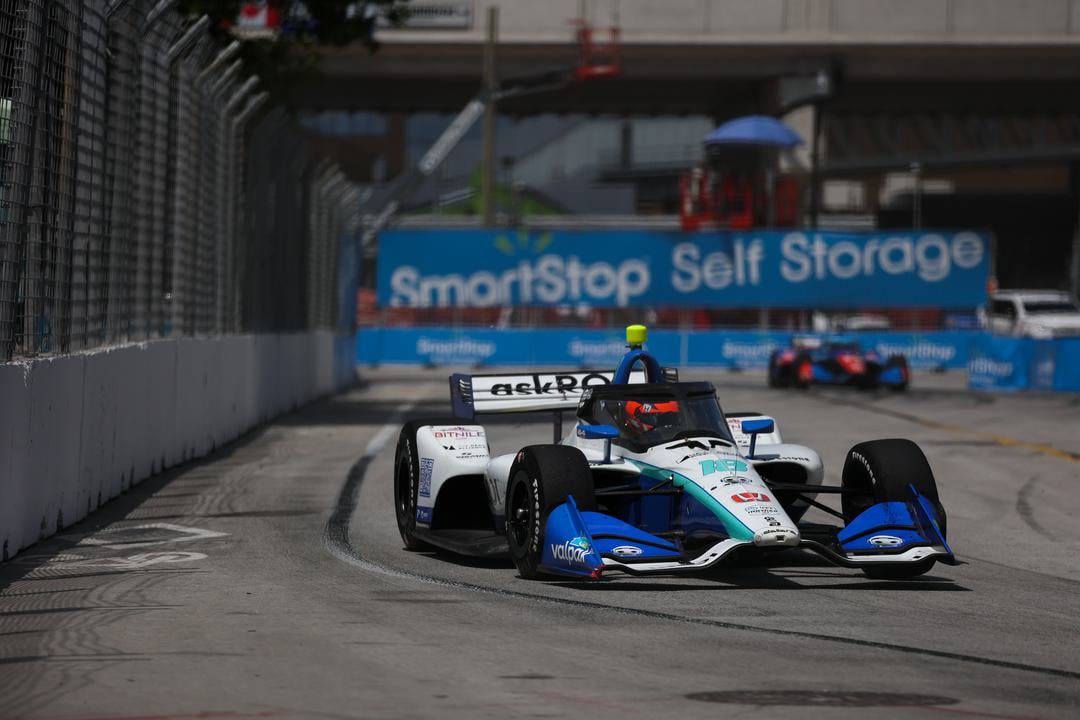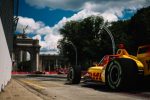In 2024, Dale Coyne Racing had zero top-10 finishes. Going into the 2025 season, Jacob Abel was under contract, but there was a vacancy in the team’s No. 18 Honda entry.
With few drivers available to choose from, Dale Coyne chose recent Ed Carpenter Racing castaway Rinus VeeKay and was immediately vindicated for his decision-making process as VeeKay finished ninth in the season-opening race at St. Petersburg while setting the race’s second-fastest lap.
Flash in the pan? Hardly. Since St. Petersburg, VeeKay has had a fourth at Barber Motorsports Park and four top-10s over the next six races.
But then IndyCar went north of the border, where VeeKay has a pair of wins from his 2018 championship-winning season of USF Pro 2000.
Through the weekend, there was anticipation of a similar situation to St. Petersburg, where Firestone’s softer green sidewall Alternate compound tires weren’t going to last many laps, so many teams decided to start the race on those tires and pit at the end of the race’s second lap.
Scott McLaughlin‘s accident forced most of those teams to wait until the race’s fourth lap to pit to get off the Alternates.
Of the 15 drivers that started on the Alternate compound tires, 13 of them had pitted under the race’s first full-course yellow.
The two that didn’t? VeeKay and Kyffin Simpson.
Remember those names later.
VeeKay fell to fourth place behind Louis Foster and David Malukas and then fell several more positions before pitting on lap 13. Simpson would fall all the way to 16th before the race’s second full-course yellow for Christian Rasmussen‘s spinning car.
Who pitted just a few laps before the yellow? VeeKay. Strategist and team owner Dale Coyne had possibly just hit the jackpot in a major strategic gamble.
Before the season started, IndyCar had increased Toronto’s race length by five laps to 90, in an effort to reduce the chances for a driver and team to do the race on two pit stops.
With VeeKay staying out until lap 13 and, more importantly, maintaining his position in the top five, that enabled Coyne to put his driver on a two-stop strategy, provided the Dutch racer saved a bunch of fuel and that there were more full-course yellows.
Well, there were more yellows. VeeKay benefitted from the misfortunes of Alexander Rossi, Abel, Josef Newgarden, Nolan Siegel and Devlin DeFrancesco to stretch his fuel window so he could pit on lap 57.
Unfortunately, VeeKay could not push too hard or he’d risk running out of fuel, hence why he lost the lead of the race to eventual winner Pato O’Ward in the pit sequence when O’Ward stopped one lap later.
Don’t believe me? Here are some statistics. VeeKay’s time on pit road was 1.1331 seconds longer than O’Ward’s and VeeKay’s in-lap was .5228 seconds slower than O’Ward’s in-lap. That’s 1.6559 seconds lost and VeeKay’s lead was 1.1025 seconds on his lap before pitting.
Once VeeKay lost the lead in the final pit stop sequence, his race was run. The goal for the rest of the race was simple: maintain second place and hope O’Ward makes a mistake.
O’Ward maintained his lead and VeeKay kept a firm grip on second place, but a couple of critical details cannot be overlooked here.
First, VeeKay ran the last 77 laps of the race on two sets of used Primary compound tires. To put that feat into perspective, only two other drivers in the top 15 by race’s end ran a stint on primaries; Callum Ilott (eighth place) from laps 4-34 and Will Power (11th place) from laps 57-90.
To maintain a place in the top three while running on scuffed primary compound tires is no small accomplishment. To do so while your closest competition is on the same fuel strategy as you, but stopped one lap late,r is that much more difficult.
Which brings me to my final point. Simpson stayed on the alternate compound tires until his pit stop on lap 16. During the green flag run between the McLaughlin and Rasmussen cautions, Simpson fell from fourth to 16th place and was nearly 25 seconds behind Alex Palou, who was leading the race at the time of Rasmussen’s spin.
Simpson lost over 2 seconds to Palou in the time between VeeKay’s pit stop and Rasmussen’s spin. In that time, Simpson lost four positions.
Simpson possibly had a second-place run going, but lost too many positions before his first stop. That’s part of the risks you take while racing.
And that’s why Coyne’s call to bring VeeKay in when he started falling back was so brilliant.
The caution just after pitting was just the icing on the cake.
At least this time around, the cake didn’t have razor blades in it.
Christopher DeHarde has covered IndyCar racing and the Road to Indy for various outlets since 2014. In addition to open wheel racing, DeHarde has also covered IMSA and various short track racing events around Indiana. Originally from New Orleans, DeHarde moved to the Indianapolis area in 2017 to further pursue a career as a motorsports writer.




